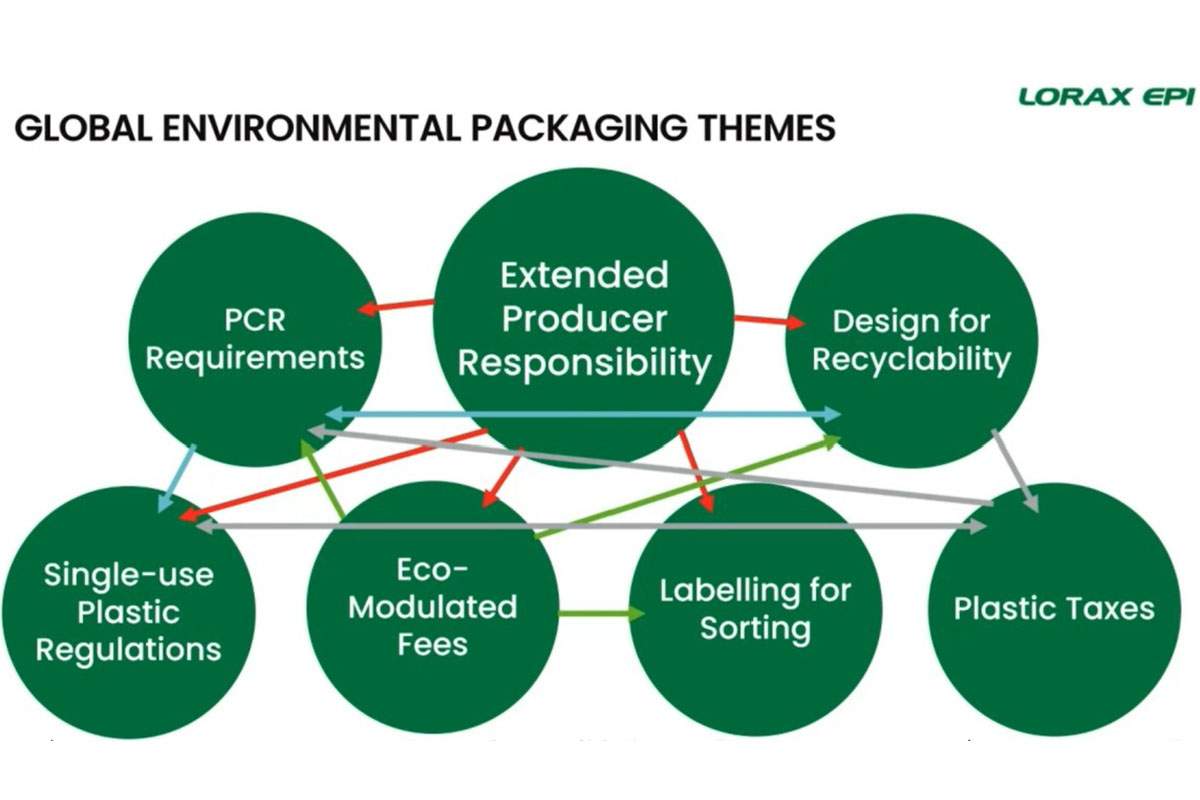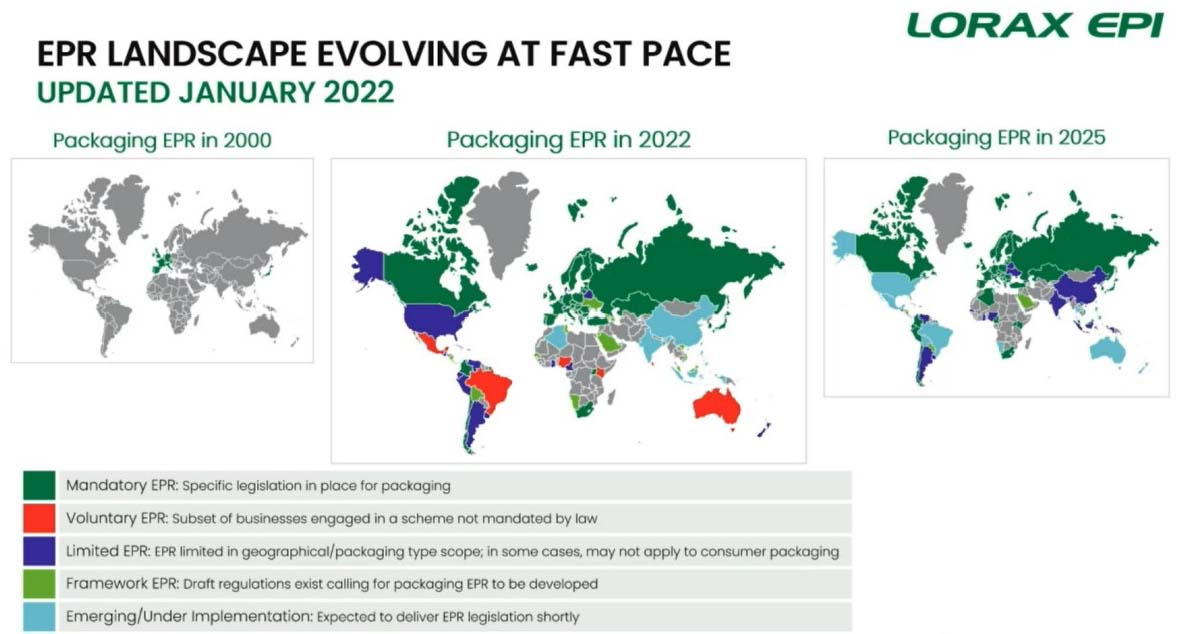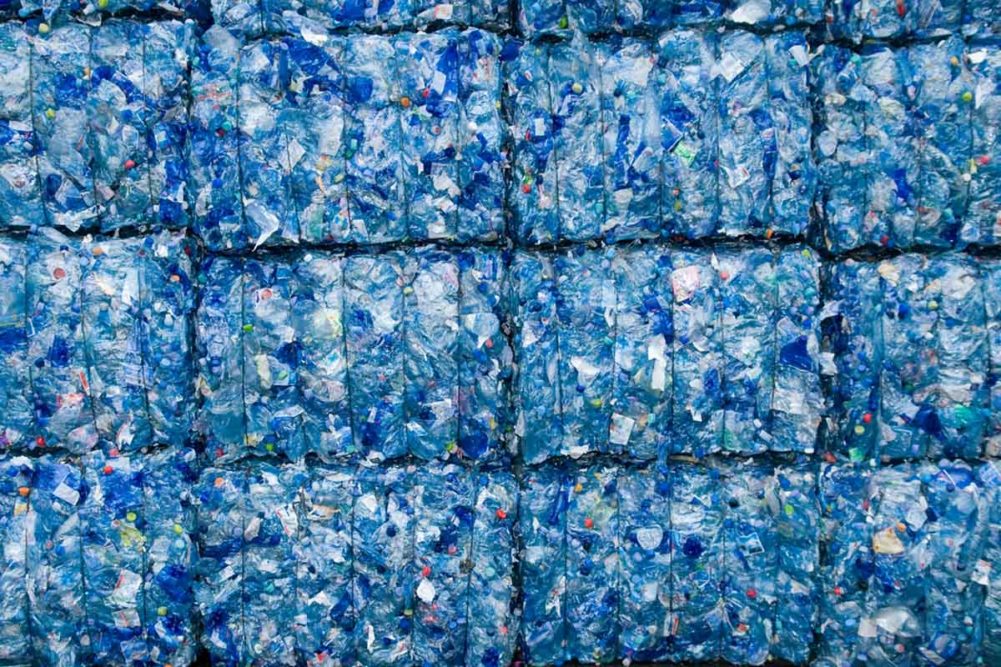The rising concern of sustainability in the pet food industry is nothing new; the use of alternative and insect proteins, rendered ingredients and byproducts have all become hot topics within the industry. Though many manufacturers are tackling sustainability through formulation of pet food, others are looking at something else: packaging.
Determined to help pet companies achieve more sustainable operations, the Pet Sustainability Coalition (PSC) held its UnPacked22 event, which brought together the industry to discuss the importance of sustainability in packaging from Feb. 22 to 24.
During the event, Sandi Childs, a consultant from the Association of Plastic Recyclers (APR), and Michelle Carvell, chief operating officer of Lorax Compliance, shared current trends on sustainable packaging legislation and its future for North America and the European Union (EU).
 Source: Lorax Compliance
Source: Lorax Compliance
In North America
Regarding North American packaging legislation and focusing primarily on the United States, Childs acknowledged that packaging sustainability is important for those in the pet food industry, especially relating to plastic.
“We know that plastics are taking a huge reputational hit due to the realities of environmental pollution,” Childs explained. “And then, because of this, brands are under a lot of pressure to make their packaging more sustainable. Since plastic is a very efficient material, sustainable plastic materials are a big focus… There's a huge demand for postconsumer recycled plastic.”
Though there is a huge demand for more sustainable plastic pet food packaging, the recycling rates of these plastics pose a larger problem, which states throughout the nation are just beginning to address.
“The recycling rates for many plastics are pretty stagnant and they have been for a long time,” Childs said. “So, at the nexus of all of this are potential public policy solutions, which we’re seeing a lot of now after not seeing it for many years.”
Globally, there are three types of policy proposals: extended producer responsibility (EPR), recycled content mandates, and a bottle deposit and return system (Bottle Bills). According to Childs, EPR is by far the most popular and widespread in the United States and is currently in place in Oregon and Maine. Currently, these EPR legislations have a producer responsibility side and an eco-modulation side.
“Producer responsibility organizations (PROs) in [Oregon] will be both operationally and financially responsible for the collection and recycling of a specific list of materials,” Childs said. “The PRO will set the fees and the members will pay the fees on covered products sold in the state. The eco modulation [part] gives consideration to the post-consumer content, product package ratio, material choice, lifecycle impact and recycling rate [of the plastic materials].”
However, in Maine the EPR works a bit differently compared to Oregon, mimicking Canada’s old EPR legislation.
“They have a different approach to EPR in Maine, where there will be only one product stewardship organization (PSO), under contract with the state to operate that stewardship program, and all producers are required to join that PSO, [which will] be responsible for the financial costs of the program,” Childs explained. “[The PSO] will pass the money from packaging producers to the local governments to reimburse them for the costs of managing recycling systems.”
Even if Maine’s EPR legislation works like intended, Childs notes the obvious problems it creates for producers of plastic packaging.
“There's been an ongoing dialogue about how fair that is… If the producers have no say in what materials are collected, how they're collected, or how they're processed and marketed, is it really fair to have them pay all the costs for something they don't have any control over at all?”
Childs also looked at recycled content mandates throughout the United States, specifically in Washington, New Jersey and New York. In Washington, the mandate includes plastics, even trash bags, and householding cleaning and personal product packaging.
“The interesting thing about the Washington law, though, is that these requirements are not regulatory, they're not to be decided later – they are written into the legislation. There are already immediate penalties for not complying because it's law… it's kind of interesting, because once it's signed into law, it's difficult to influence what happens.”
New Jersey and New York, however, are treating their recycled content mandates a bit differently.
“The New Jersey and New York recycle content requirements… do include plastic film reusable bags and plastic trash bags as targets for incorporating recycled content,” Childs explained. “New York is doing a bit of a hybrid extended producer responsibility law, which will include minimum content levels for plastic packaging.”
The problem with creating packaging sustainability in the United States is dealing with at least 50 different sustainable packaging laws. If each state created its own legislation and requirements for plastic or packaging recycling, there would be an extremely large problem for the supply chain.
“If every state… passed a recycled content law that was like Washington's, or New York's, or anybody's for that matter, it would cause a really interesting supply problem,” Childs cautioned. “It’s not going to be easy.”
Even if the United States finalizes packaging sustainability and recycling legislation, determining all the financials and how the materials will be collected, more questions will arise. Where will all the plastics go? How will the government ensure and achieve full participation?
“Recycled plastic created in the system has to go somewhere and putting it back into new plastic packaging products is a whole topic we could talk about for hours,” Childs said. “There are food contact regulations, there are quality issues and there's volume issues [that can prevent all the collected plastic from being upcycled into something else]… This collection and supply side must be addressed if we're ever going to get near to meeting these goals. We have to figure out ways to collect more plastics.
“I've been in this industry for over 30 years, and I have worked on numerous programs to increase supply of recycled materials. It's complicated and not only a technological problem,” Childs added. “Somewhere in between the refrigerator in the curb, you've got a human being that has to understand and be motivated to participate. And then you have to think about all of the venues, events, commercial establishments, restaurants and campgrounds [which use plastic materials]. This stuff is everywhere; it's not just in your typical single-family household. So, we all need to put our heads together and figure that out, too.”
 Source: Lorax Compliance
Source: Lorax Compliance
In the European Union
In discussing packaging legislation throughout the EU, Carvell noted the wide variety of legislation and policies, posing a challenge to manufacturers trying to export their products. Among the variety of legislation, Carvell has also noticed the rapid pace at which countries in the EU, and even in other parts of the globe, have developed such legislation, especially EPR policies.
“In the last 20 years, we've seen a huge explosion in producer responsibility legislation for packaging around the world, and that now comes in many different formats,” Carvell explained. “We can see many different types of producer responsibility legislation emerging, be it mandatory producer responsibility or voluntary, maybe looking at the limited set of products, maybe just bringing in framework legislation.
“As we look ahead to 2025 and beyond, the explosion of producer responsibility legislation is probably not going to let up,” said Michelle Carvell, chief operating officer of Lorax Compliance.
“As we look ahead to 2025 and beyond, the explosion of producer responsibility legislation is probably not going to let up,” Carvell added. “We see a lot of the policies that have been put forward here are now replicating themselves around the world in many ways… That explosion of EPR legislation that we see now has gone way beyond just the core countries [in the EU] that started in the 2000s, and now reaches out far into Russia and also other countries as well with Ukraine, et cetera also having legislation.”
Throughout the EU, Carvell noted the big themes surrounding much of the packaging legislation, including eco-modulation, heavy regulations on single-use plastics, requirements of post-consumer recycled content (PCR), modulating fees, labeling, recyclability package design and plastic taxes. But the most significant theme severely affecting producers is eco-modulation and its prices.
“Eco modulation really means that you're looking at how the end-of-life cost of the packaging is reflected in the price the producers have to pay as part of the reporting structure,” Carvell said. “For many years, the price of producer responsibility… was always simply a weight-based fee. However much plastic, paper or glass you placed into the market, you would just pay a price per ton, or a price per kilo, acquired. The only way to reduce that would have been to try to lightweight your packaging, which would have lowered greenhouse gas impacts. But really, there wasn't a lot you could do, or there wasn't a lot to incentivize you to make significant change.
“However, over the last few years, there is a policy coming in across all European countries, which looks at trying to understand how much it costs to recover and to recycle that packaging at the end of life,” Carvell added. “Which means that they would not just look at material, but they would also be looking at things like rigid or flexible format, is it a multi or singular piece of packaging, and other criteria as well.”
EU legislation is also beginning to apply penalties and incentives to eco-modulation, according to Carvell.
“We're also seeing a third level of modulation come in, which is really where we can see some discounts or penalties applied in addition to a baseline cost, which can be sometimes based on labeling or something that could make the packaging disruptive, if it's contaminated, or if it contains recycled content,” Carvell said. “Ten to 12 years ago we had a single plastics fee in France. Over time, that moved to become a more flexible structure with seven different categories of plastics, and each of those have a different fee.”
What Carvell is also seeing throughout the EU is a renewed focus on package labeling and design, both of which consider consumer recyclability.
“What we see being phased in… is a lot of labeling to do with the sortation of packaging, including information for consumers on how to manage the packaging at the at the end of life,” Carvell explained. “So, really trying to bring consumers into this picture of packaging responsibility as well.”
Outside of the EU and its trends, Carvell noted the importance of keeping tabs on package legislation in Asian countries.
“Don't overlook countries like China and India,” Carvell cautioned. “Those countries have been talking now for a number of years about putting in [EPR legislation]. I still think we're going to see that by about 2025 those countries will have programs in place… Whatever your company is currently paying for their producer responsibility fees in Europe could easily be dwarfed by maybe a Chinese or Indian market.”
Though Carvell sees potential conflictions for companies struggling with the variety of EU and global legislation, she said she hopes that legislation will begin to harmonize and further appeal to consumer responsibility, allowing producers to share some of the sustainability load.
“One of the nice things about a lot of this legislation coming through, while there is a lot of legislation coming through, [is] they've understood that it's not going to simply be a silver bullet with producer responsibility to increase recycling. Lots of other things have to be in place,” Carvell said. “If the consumers aren't engaged through labeling than the collection won't be done, if the modulator fees aren't there, then designs won't change.”
Read more about packaging solutions and trends for pet food and treats.




